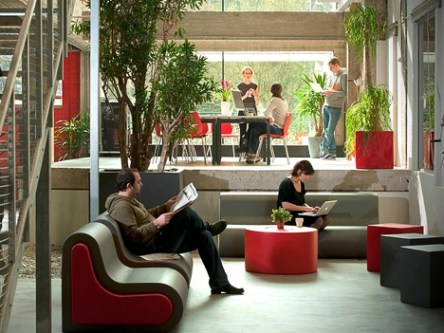Home is where the heart is, as well as the home office for some. All the time at home in front of a computer, however, can lead to feelings of isolation, a lack of inspiration, and a lack of meeting space for collaboration. Remote employees and freelancers turn to coworking spaces for help. To avoid a hectic commute, they seek coworking offices that are as close to home as possible. Herein lies renters’ problem that is an opportunity for multifamily and coworking owners. As the number of digital nomads grows, it outpaces coworking space availability especially in midsize and tertiary markets. Many multifamily communities aren’t equipped with the space, staff, or equipment needed to successfully operate their own coworking space on premises. This is where a collaboration between coworking organizations and multifamily properties can fill the void. Renters want coworking space but providers face challenges The 2020 National Multi-housing Council & Kingsley Apartment Resident Preferences Survey indicates that 46% of renters are interested in coworking space as a community amenity. Additionally, 48% are interested in conference or meeting rooms and 37% take interest in makerspace and DIY rooms. Unfortunately for renters outside of major metropolitan areas, coworking spaces are too far away, face limited availability, or are quite pricey. Some property managers will accommodate renters by creating a coworking space within the community. When space and staff are limited, that simply isn’t an option. For coworking firms outside of major metros, high rents may necessary to stay afloat with inconsistent membership revenues. A reliable base of clients would offer stability and an opportunity for growth but getting such leads is a struggle. Multifamily property and coworking leadership may be able to work together with mutual benefit. Considerations for coworking and multifamily property managers Space...
Shared Space Moving Up
Matrix Special Report
The coworking industry is growing rapidly, encompassing 93.2 million square feet in the top 50 U.S. office markets and making inroads in suburban spaces as well. A new special report from Yardi Matrix portrays a practice that thrives in cities with large technology sectors and in markets with office vacancy rates significantly below the 13.5% national average, including Manhattan, N.Y., San Francisco, Seattle and Boston. Areas with vacancy rates in the high teens, among them Houston and Dallas, have much less coworking space as a percentage of total stock. While 47% of coworking space is concentrated in just six traditional primary commercial real estate markets—New York City, Los Angeles, Washington, D.C., Chicago, Boston and San Francisco—“we expect that coworking will rise in suburban office markets” as the industry matures, the report says. These areas tend to draw clients from home-based workers who want an office for work and socializing purposes and from large corporations that establish small satellite offices. While highly visible turmoil surrounding industry leader WeWork fosters the impression that the entire business model is at risk, “most signs point to coworking as a growth industry that remains in the early stages of development,” the report says. New business models, such as establishing coworking properties in shopping malls and other non-traditional settings, are emerging as well. Get up to speed on all of this dynamic segment’s moving parts, prospects for further growth and risk factors in the new Yardi Matrix special report, “Shared Space: Coworking’s Rapid Growth Set to be...
Shared Workspaces
10 Tips for Multifamily
Looking for a way to increase occupancy without slashing prices? Creative value-add amenities can distinguish your property from competitors. One such value-add feature is a coworking space. The demand for shared work spaces is on the rise. You can benefit from this by transforming an existing area into a coworking space for residents. Coworking Spaces for Multifamily? Nationwide, there are more than 57.3 million freelancers. In corporate America, 55 percent of hiring managers believe telecommuting among full-time employees is becoming a staple in their business structure. That number is expected to rise. Employers responded that nearly 38 percent of their workforce will be telecommuting within the next decade. So where are all of these freelancers and remote employees getting their work done? Their homes and coffee shops, mostly. Fortunately for you, you can be both and attract the revenue for yourself. You can create a shared workspace on your property by converting an existing conference room or business office. Add some chairs and a coffee maker and you’re done! Almost .. here’s the next steps. Must-Have Coworking Space Features Coworking offices are profitable and you can benefit from their popularity and capacity to drive revenue. You will, however, need more than a coffee maker and some chairs to get the most out of the space’s earning potential. Here are five must-haves to make your space functional. High-speed connectivity is a must. You will need to decide whether wi-fi or cable connection is right for your building. Comfortable, customizable seating is just as important as connectivity. Workers must feel comfortable if you want them to return and perceive your workspace as a reason to sign or renew their lease. To increase comfort, equip your space with a combination of adjustable office chairs at desks and...
Coworking Marketing
Strategies and Ideas
As the coworking and shared space industry continues to grow and evolve, it’s becoming much more evident that profitability is not only viable, there are ways to maximize and continue to grow your profits as an operator. Let’s dive into the best coworking marketing strategy for maximum growth. Host Events You’ve likely heard about the potential for fantastic events at coworking spaces. One of the major keys to building your brand is to hold events that are open to the local community. It’s free advertising! People who would otherwise have never stepped foot in your space get firsthand access to all the benefits your space provides. Even if they are not coworking candidates, word of mouth is one of your biggest assets. The more people know about your location, have been inside and can speak to its benefits, the better for you of course. Here are some ideas for events that you could organize within your space: Community panel discussions ‘Breakfast and Learn’ / happy hours Singles’ meetup events Yoga classes Also, keep in mind, if your space does not have 24/7 access, a great way to increase revenue is to host private events after hours. Whether it’s birthday parties, receptions, sporting event watch parties, or just about anything else that you have the room for and would take place past typical working hours. Last year’s Global Coworking Survey revealed that 21% of operators found organizing events to be a top challenge for them, and 50% said attracting new members was a top challenge. These events, whether during or after hours, will solve for a large part of both of those obstacles. Want to learn more about coworking marketing strategies? Check out the rest of this post on the Yardi Kube...
Coworking Outlook
Changing the tech landscape
Editor’s note: this coworking perspective piece was authored by Justin Harley, regional director of coworking for Yardi, in association with Property Week. Harley was a co-founder of the flexible workspace management software Hubcreate. He joined the Yardi UK team in May. Having spent most of my career in the flexible workspace sector, I could not be more enthusiastic about how bright the future is for coworking and flexspace, and furthermore I am delighted to see technology and software leaders such as Yardi investing heavily in technology to fuel the growth and development of the sector. I have been privileged to see the coworking and flexspace sector grow from a few London-based serviced offices to what it is today, one of the fastest-growing parts of the real estate world. That said, it still only accounts for 4% of all deals in London, according to the latest research from Cushman & Wakefield and Colliers International. While real estate continues to develop an understanding of the coworking market, the industry is still a little shell-shocked about how it has crept up on them. That part of the real estate sector often misses the point when they debate coworking. I hear “we are not coworking, coworking doesn’t make money – when will the bubble burst?” Larger operators account for less than 13% of the market in the UK and the flexspace and coworking community is made up of businesses that care about innovation, member experience and the effect of their service on worker wellness. In short, it’s all about the customers and what makes them happy. Their obsession for customer service is what drives the industry. A happy client is a loyal client and, despite being on a flexible license, will stay for a long time. It is...
GCUC Recap
Coworking Conference Insights
Last month, Yardi Kube was introduced to the coworking world at the Global Coworking Unconference Conference (GCUC). The U.S. edition of the annual event was held in Denver from April 15-18. This popular coworking industry gathering provides attendees with extensive in-depth sessions with experts in the coworking space, educating them on financing, technology, community building, and branding. The first day of the event was a deep dive into especially hot topics for the coworking industry. Industry hot topics: making money Led by Jerome Chang of Blankspaces, the finance discussion focused on the number one way to make money as a coworking operator – through lease incentives. Fundraising methods for shared space startups include venture capital funding, personal loans, investment from friends and family members, and other avenues, but Chang shared that SBA loans for such businesses are unlikely. The average traditional office space will have about 165-185 square feet per employee. In a coworking space it could be as low as 50-70 square feet. Coworking operators can book common areas at up to 150 percent capacity, because your space won’t always be full (this uses the same logic as a gym membership: it’s possible to overbook because not everyone works out simultaneously). The biggest moneymaker, however, will be meeting rooms. They’re priced higher per hour than any other amenity or space in and should be rentable to the general public, as well as members. Virtual memberships provide a low-cost entry to members wanting to try out the industry. While individually, these memberships won’t be a primary source of income, it is a source of unlimited potential with no space restrictions. The Blankspaces model allocates 35-50 percent of space to private offices, Chang shared. And it’s important to make over 70 percent of your total available square footage...
Flexible Workspace
Topic of Yardi Think Tank
Yardi assembled a panel of flexible office experts to discuss the importance of a service ethos, how workspace providers can stand out from the competition and why the sector looks well placed to weather a possible recession. Panelists Gareth Evans, chief executive of BizSpace Katrina Larkin, co-founder of Fora Cal Lee, founder of WorkThere William Newton, president of Wiredscore Katie Whell, managing director at Pure Offices Tony Freeth, director of coworking at Yardi Simon Creasey, features editor at Property Week (chair) Flexible workspaces have been hailed as the future of offices, but as the business model continues to mature many questions arise about what this future might look like. To debate what lies ahead for flexible workspaces, Yardi put together a panel of some of the industry’s heavyweights. SC: How important is customer service for the coworking industry? GE: Customer service is what it’s all about. It’s quite interesting as a concept because one person’s customer service is another person’s lack of service. It depends on where you are regionally, what kind of centre you’re in and what people’s needs are. You can provide frothy coffee or whatever, but if that’s not what the customer wants then you’re not providing good customer service. KL: Myself and [Fora co-founder] Enrico [Sanna] come from a hospitality background, not from a workplace background. So, for us, customer service is absolutely key. We have worked with one of the top hospitality schools in Switzerland to attract the best people from the hospitality industry. WN: Before WiredScore moved into WeWork, we were with a provider who clearly hadn’t yet got what service meant. Their front of house people were security people trying to prevent people getting into the building who shouldn’t be there rather than welcoming in guests who...
Introducing Yardi Kube
Single Platform Coworking Solution
Yardi Kube™, a single platform solution for coworking and shared workspace operators, is now available. Introduced this week at the GCUC conference in Denver, Yardi Kube is designed to help coworking operators successfully grow their businesses, eliminate third party integrations, save time and offer competitive member services. With the powerful Yardi Voyager property management platform as its foundation, Yardi Kube combines accounts payable, general ledger, merchant services and more in one easy-to-use technology suite. Yardi Kube includes comprehensive accounting, online marketing integration and powerful reporting capabilities. Users will be able to easily report to owners and investors and market to new clients, all from within the platform. The member portal gives coworking members the ability to manage their profile, connect with other members, pay bills, purchase services and book space with one click. Yardi Kube can also handle management of Wi-Fi and VOIP systems. “We chose Yardi Kube because of its robust capabilities to manage our businesses. The fact that Yardi was behind the development gave us confidence in its reliability and development path,” said Willie Gutierrez, COO and CFO of Premier Workspaces, a nationwide shared workspace provider. “Yardi Kube is the long-awaited technology solution that will allow shared workspaces to scale and grow with ease,” said Dale Hersowitz, vice president of coworking at Yardi. “It maximizes efficiency, eliminates leakage and allows for real-time reporting, all in a single platform.” GCUC, which concludes tomorrow, is the world’s largest coworking event, with conferences held in five continents. About 300 attendees convened in Colorado for the event. At GCUC, the Yardi Kube team has been conducting demos of the new platform and sharing the product’s exciting features, including the accounting platform, internet listing service and prospect lifecycle tracking. “We look forward to showing the extent of Yardi’s commitment to coworking, what the future looks like for Yardi Kube, and how the platform separates itself from the competition,” said Dale Hersowitz, vice president of coworking at Yardi. GCUC attendees are invited to come by the Yardi Kube booth, #10-11, to see Yardi Kube in action. Visit yardikube.com to learn more about the benefits of an all-in-one coworking management solution for shared...
Sharing Disruption
U.S. Coworking Expands
Coworking isn’t new, but its recent growth and prominence in the U.S. office market space is. A new special report from Yardi Matrix, titled “Shared Space: Disrupting the Traditional Office,” outlines the dramatic increase in shared spaces over the past year, driven by a growing “gig economy” and employers’ desire to deploy more workers remotely, attract talent and gain more flexibility for their space. In researching 20 metros, Yardi Matrix found that 43.5 million square feet of office space was being rented as of the fourth quarter of 2018. This represented a 62% increase in shared space over the previous year and 1.7% of the total inventory. The business model for shared space is evolving to match the practice’s growth, with landlords and brokerage firms offering more amenities and flexible lease arrangements. Coworking has gained footholds in both urban markets (2.2% of stock) and suburban submarkets (1.2%). The practice is “growing as a percentage of office stock in all areas, but it is a more natural fit in urban settings due to the proximity to a greater number of workers, easier commute to urban locations and greater availability of small rental spaces in suburban areas,” the report says. “The sector is in a nascent phase, so the pace of growth is likely to pick up in coming years.” Manhattan, N.Y., ranked first in both overall amount of shared space with 13.7 million square feet, with Los Angeles second with 4.7 million square feet. The borough also had the most shared space as a percentage of total stock, 3%, with Portland, Ore., Miami, San Francisco and Austin, Texas, totaling 2.5%, 2.4%, 2.3% and 2.2%, respectively. Read the full Yardi Matrix special...
Coworking Security
7 Ways to Keep Everyone Safe
As the manager of a coworking space, you walk a fine line. Your site must offer security while helping members and guests feel welcome. The following seven tips promote digital and physical security without interrupting ease-of-use. Create a Warm, Automated Welcome Automated attendance trackers deliver convenient yet controlled access to your shared workspace. Combine Kisi and KUBE door access systems to manage member and visitor logs as well as billing details. There is no need to have users register and pay for common use areas in advance. Users pay as they go, minimizing cancellations and billing disputes. As an added convenience, any user with a mobile device can begin working automatically. With access and billing aside, your reception staff can focus on welcoming clients, answering questions, and placemaking. Offer Private Wi-Fi As an alternative to shared wi-fi networks, private networks provide excellent digital security. Each user receives a unique code that doesn’t overlap with fellow users’ access. Consider linking access with membership. A single code issued to all members and guests does not provide the protection you need. Link access codes to users’ unique membership level as an additional layer of security. Have that code expire with the membership or expire after a certain duration of time for guests. Switch Up Guest Access If individualized wi-fi credentials for guests seems tedious, consider a simple guest wi-fi network and password. For added security, update log-ins at least every quarter, if not every month. Encourage Privacy with Filters Install an IP filtering system that can minimize undesirable data sharing and burdensome traffic loads. Not all data theft occurs digitally. Applying privacy screen filters on your in-house computer monitors limits the access of wandering eyes. Benefit from Member Education Education is key to risk mitigation. During new...










